Madhya Pradesh and Gujarat Tour
Madhya Pradesh and Gujarat Tour – Discover the Cultural Soul of Central & Western India
Embark on a journey through India's lesser-explored yet culturally rich regions with the Madhya Pradesh and Gujarat Tour. From ancient Buddhist stupas and prehistoric rock shelters to grand temples, palaces, and vibrant tribal traditions, this tour unveils a deeply spiritual and historical side of India. Visit iconic sites like Khajuraho, Sanchi, Ujjain, and Bhimbetka in Madhya Pradesh, followed by the cultural marvels and wildlife of Gujarat, including Ahmedabad, Gir National Park, and more.
Tour Highlights – Madhya Pradesh & Gujarat Tour
- Khajuraho: Explore the UNESCO World Heritage temples famous for their intricate and expressive carvings representing spirituality and sensuality.
- Sanchi: Visit the Great Stupa of Sanchi – a significant Buddhist pilgrimage site dating back to the 3rd century BCE, with detailed gateways and ancient relics.
- Ujjain: Discover one of India's oldest and most sacred cities, home to the Mahakaleshwar Jyotirlinga Temple and the Kumbh Mela site.
- Bhimbetka: Step back in time at the Bhimbetka rock shelters with prehistoric cave paintings, recognized as one of the earliest evidences of human life in India.
- Bhopal: Visit the capital city’s top attractions including the Bharat Bhavan arts complex, Upper Lake, and the Museum of Man. Optional excursion to Bhojpur and Islamnagar.
- Indore & Mandu: Explore the vibrant markets of Indore and the historic ruins and romantic palaces of Mandu – a city of architectural grandeur and tragic love tales.
- Ahmedabad: Begin the Gujarat segment with Sabarmati Ashram, Jama Masjid, Adalaj Stepwell, and the old city’s pols and markets.
- Rajkot & Junagadh: Visit the historic city of Rajkot and the ancient monuments and Girnar hills of Junagadh.
- Gir National Park: Go on a thrilling jeep safari in Gir – the only place in the world to spot the rare Asiatic Lions in their natural habitat.
- Somnath & Dwarka: Pay homage at two of India’s most revered Jyotirlinga temples – Somnath on the Arabian Sea coast and Dwarkadhish Temple in Lord Krishna’s sacred city.
- Bhavnagar & Palitana: Visit the Jain pilgrimage site of Palitana with its thousand-plus hilltop temples and explore Bhavnagar’s coastal heritage.
- Vadodara (Baroda): Explore the Laxmi Vilas Palace, Champaner-Pavagadh Archaeological Park, and the rich cultural vibe of Gujarat’s royal city.
- Seamless Travel: Enjoy guided sightseeing, comfortable accommodation, cultural performances, and private transportation across two incredible states.
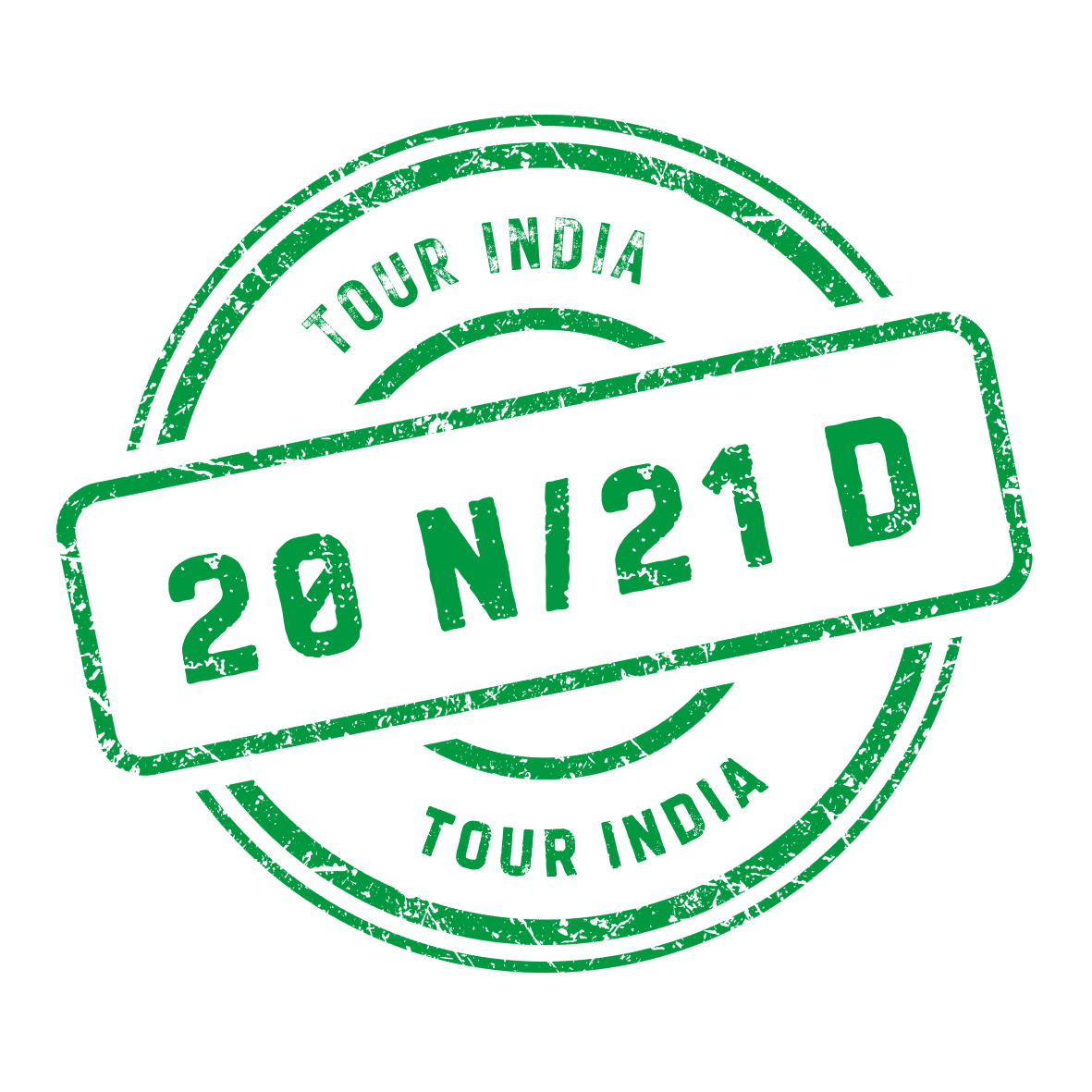
Delhi - Orchha - Khajuraho - Bandhavgarh - Jabalpur - Pachmari - Bhopal - Sanchi - Ujjain - Dhar - Mandu - Vadodra (Baroda) - Ahmedabad - Utelia - Palitana - Bhavnagar - Mumbai (Bombay)
Itinerary Overview
Day 1: Home - Delhi
Assistance on arrival at Delhi International airport by our tour representative, transfer to hotel. Relax and overnight at hotel in Delhi.
Day 2: Delhi
Morning take a sightseeing tour of Old & New Delhi. Morning visit Old Delhi: The important places in Old Delhi include the majestic Red Fort, the historical Chandni Chowk and if time permits you can visit Raj Ghat the Memoir of Mahatma Gandhi. Afternoon visit New Delhi visit the Rashtrapati Bhawan, the one-time imperial residence of the British viceroys; the India Gate, a memorial raised in honour of the Indian soldiers martyred during the Afghan war; the Laxmi Narayan Temple, built by the Birlas, one of India’s leading industrial families; Qutab Minar, built by Qutub-ud-din Aibek of the Slave Dynasty; and the lotus-shaped Baha’i Temple.
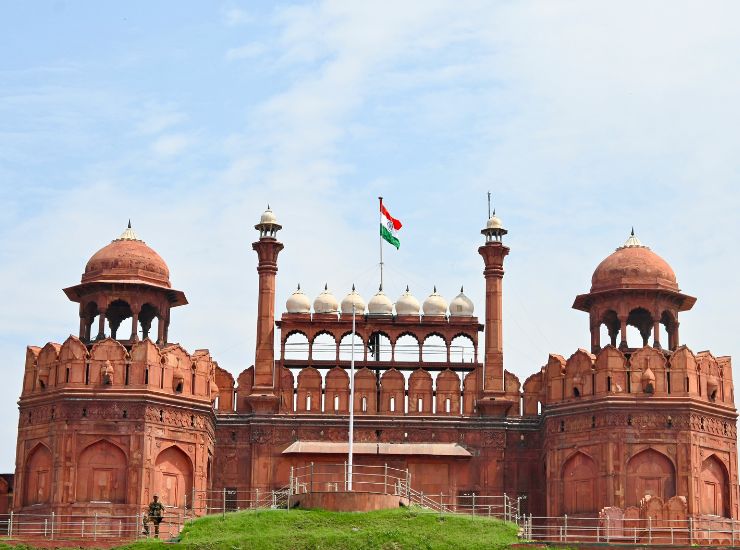
Day 3: Delhi - Jhansi - Orchha (16 kms - 20 minutes)
Early morning transfer to the Station to take train for Jhansi – the gateway to Bundelkhand. Jhansi is known for the valour of Rani Jhansi. It was here she fought the British. Arrive Jhansi and proceed to Orcha- medieval city of Orcha flanked by the river Betwa, known for its palaces and temples of the 16th and 17th century built by Bundela rulers. Evening free to explore Orchha on own. Overnight in Orchha.
Day 04: Orchha - Khajuraho (178 kms - 4 hours)
Morning sightseeing tour of Orchha visiting Jehangir Mahal - the largest of the palaces , the Raj Mahal with its murals and the Raj Praveen Mahal built near a garden, You would also visit Dinman Hardaul`s palace with its interesting story. The temples of Orchha are highly preserved. The two main temples are the Ram Raja Temple with its lofty spires and the Chaturbhuj temple. Later in the afternoon drive to Khajuraho, the ancient capital of the Chandela Kings. Khajuraho is known for its magnificent carved temples dedicated to Lord Shiva, Lord Vishnu and the Jain Tirthankaras. These temples were built between 950 A.D. and 1050 A.D. These temples represent some of the most exquisite specimens of medieval India, now declared a world heritage site by UNESCO. On arrival in Khajuraho transfer to hotel. Relax and overnight at the hotel in Khajuraho.
Day 5 : Khajuraho
This morning, visit famous temples of the western group, built by Chandela kings about 1000 years back. The 89 temples represent are dedicated to Shiva, Vishnu and Brahma. The main shrines are ornately carved with massive pillars and arches. The ceilings and walls are adorned with exquisite carvings depicting on the interests in human life, feasts, hunting's, music, dances, love.!. Afternoon, visit eastern group temples dedicated to Jainism with beautiful sculptures. Later take a walk into the village of the craftsmen. Overnight at the hotel in Khajuraho.
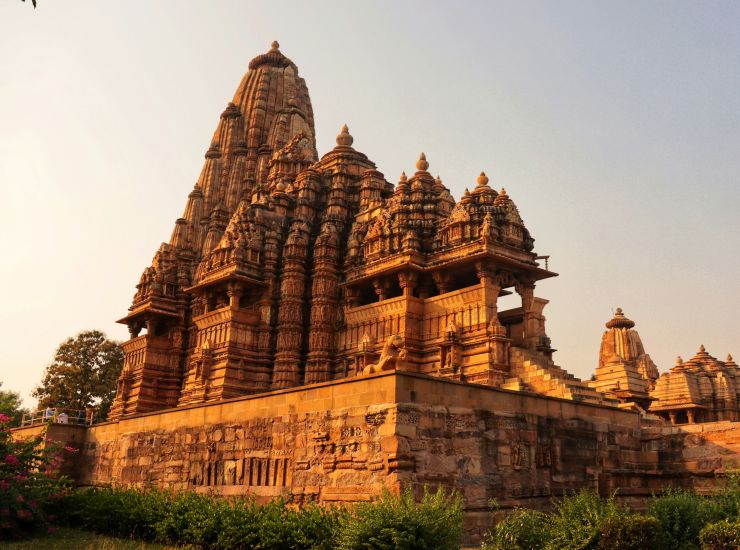
Day 6: Khajuraho - Bandhavgarh (270 km - 5 to 6 hours)
This morning, depart for Bandhavgarh National Park situated in the forest of the erstwhile State of Rewa. The National Park lies in the heart of the Vindhyan Mountain Range. Besides its enchanting landscape formed by the Sal forest in the valleys and majestic tree clad hills in the backdrop. It is famous for its rich variety of wildlife and archaeological remains of the Kalchuri period. The park area is hilly and is dominated by the majestic Bandhavgarh fort, built in 14th century. After Lunch late in the afternoon, proceed for the Jeep safari into the jungle to observe animals. Overnight at the Lodge.
Day 7: Bandhavgarh
The day is dedicated to take safaris in the reserve with a naturalist, in search of the Tiger, Leopard, Bear, Bison, Chital, Sambhar, Nilgai, Chinkara, Chowsingha, Barking deer, and varieties birds such as Peacock, Paradise fly catchers, Jungle Fowl, Golden. Day in the jungle. Overnight in Bandhavgarh.
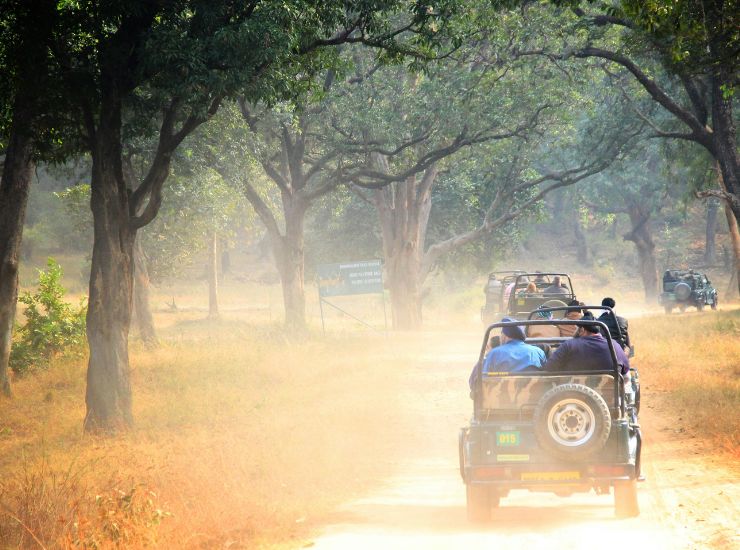
Day 8: Bandhavgarh - Jabalpur (200 km)
In the morning depart for Jabalpur, the old capital of the Gonda Kings during the 12th century, thereafter the seat of the Kalchuri dynasty is a charming city with spacious cantonment with its colonial residences and barracks. Today Jabalpur is an important administrative centre, a bustle with commercial activity. In the afternoon we go for an excursion to BHERAGHAT, to take a boat to see the famous 'marble rocks' that rise like cliffs from the river Narmada. On return, visit the MADAN MAHAL FORT- Built by the Gonda ruler, Raja Madan Shah, in 1116, perched atop a rocky hill. Overnight in Jabalpur.
Day 9 : Jabalpur - Pachmari (273 kms - 5 to 6 hours)
In the morning we depart for Pachmari which is Madhya Pradesh's most verdant jewel, a place where nature has found exquisite expression in myriad enchanting ways. The landscape is characterized by rugged hills, forests and deep ravines. There is also a possibility to see the ancient cave shelters in the Mahadeo Hills is an astonishing richness in rock paintings. Walk through the valleys and ravines to admire the natural beauty.
Day 10 : Pachmari - Bhimbhetka - Bhopal (195 kms)
Morning checkout and drive to Bhopal enroute visiting the famous Bhimbetka caves surrounded by the northern fringe of the Vindhyan ranges, are believed to have provided shelter to the primitive man. The caves or the rock shelters belonging to the Neolithic age number more than 600. Inside most of these caves are the paintings that depict, in vivid panoramic detail, the life of the pre-historic cave dwellers. The oldest paintings are believed to be up to 12,000 years old. Later proceed to Bhopal, on arrival transfer to hotel. Evening free for individual activities, overnight at the hotel.
Day 11 : Bhopal – Sanchi – Vidisha – Udaigiri – Bhopal
Morning take an excursion tour to Sanchi, Vidisha & Udyagiri. Located about 46 km northeast of Bhopal, the town of Sanchi is famous for the Buddhist works of art dating from the 3rd century BC to the 12th century AD. The ancient stupas, monasteries, temples, and pillars form a major source of attraction here. Of these, the most famous is the Sanchi Stupa 1, originally built by the Mauryan Emperor Ashoka. Later drive to Vidisha 10 kms from Sanchi, Vidisha or Besnagar as it was known then, was an important trade centre in Emperor Ashoka's time. On his way to Ujjayani, when he was still a viceroy, he stopped here and married the daughter of a wealthy local businessman. The ruins of a 2nd century BC Brahmin shrine dedicated to Lord Vishnu, show traces of lime mortar – the earliest use of cement in India. Located at the confluence of the Betwa and Beas rivers, Vidisha was renamed Bhilsa by the Muslims, who built the now ruined Bija Mandal, a mosque constructed from the remains of Hindu temples and the Gumbaz-ka-Maqbara. Vidisha later passed on to the Malwa Sultans, the Mughals and then the Scindias. Later proceed to UDAIGIRI CAVES Just 5 kms from Vidashi is Udaigiri Groups of rock cut sanctuaries carved into the sandstone hillside form the Udaigiri Caves, There are 20 caves, out of which 18 are Hindu and the other 2 are Jain. An inscription in one of the caves indicates that they were produced during the reign of Chandragupta II, between 382-401 AD. The caves have been numbered, probably in the sequence in which they were excavated. Cave 5 depicts Lord Vishnu in a beautiful carving in his Varaha (boar) incarnation holding the earth goddess Prithvi on one tusk. Another large sculpture is that of a reclining Lord Vishnu. Cave 20 is particularly interesting, with detailed Jain carvings. On top of the hill are the ruins of a 6th century AD Gupta temple. Later early evening drive back to Bhopal for overnight.
Day 12: Bhopal – Ujjain – Indore (186 kms – 4 hrs)
Morning drive to Indore enroute visiting Ujjain - situated on the banks of the river Shipra, regarded since times immemorial as sacred. The belief in the sacredness of Shipra, has its origins in the ancient Hindu mythological tale of churning of the Ocean by the Gods and the Demons, with Vasuki, the serpent as the rope. The ocean bed first yielded fourteen gems, then Lakshmi, the Goddess of wealth, and finally the coveted vessel of Nectar. Then began the wild scramble for immortality with the demons chasing the Gods across the skies, and in the process, a few drops were spilt, and fell at Hardwar, Nasik, Prayag, and Ujjayini. Hence the sanctity of the waters of the Shipra. Later proceed to Indore, on arrival transfer to hotel. Day free to relax for some time later visit City of Indore famous for its glass bangles and jewellery, Indore has some of the best architectural marvels that belong to the Holkar dynasty. The Rajwada or the Old Palace (a major centre of attraction), Lalbagh palace, (another architectural wonder), Kanch Mandir (a marvellous Jain temple), Chattri Bagh (the memorial with some canopies) and the Bada Ganapati (the largest Ganapati statue in the world) are some of the attractions you must visit in Indore. Moreover, Indore is famous as a shopper/’s paradise. The Khajuri Bazaar offers you unique shopping options of gold and silver work, cloth, leather work and traditional garments. Moreover, there are the Sarafa Market that specialises in snacks and jewellery and the Kasera Bazaar that specialises in metalwork where you can indulge in the variety displayed for selling. The Chanderi and Maheshwari silks of Indore are the other famous attractions of this city. Overnight in Indore.
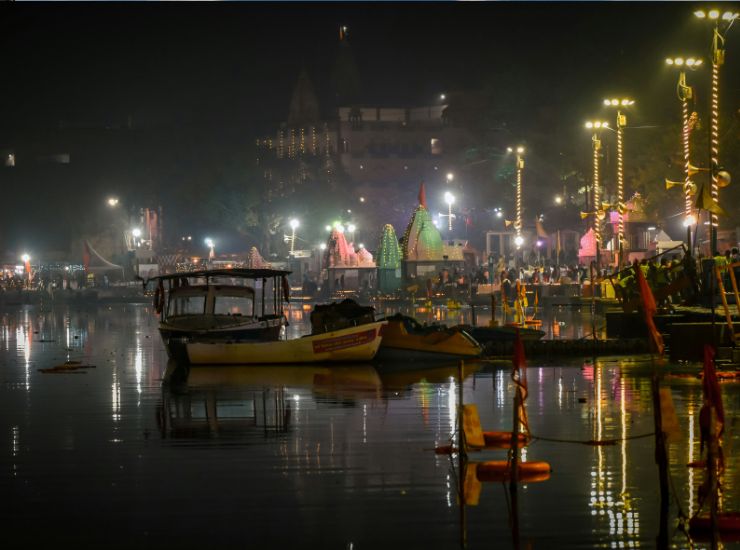
Day 13: Indore – Omkareshwar – Maheshwar – Indore (90 kms – one way – 2 hours)
Morning take an excursion tour to Omkareshwar & Maheshwar. Located a few kilometers away from Indore town is a small island at the confluence of the Narmada and Kaveri rivers in the state. The island is shaped like the holy Hindu symbol ’Om’ and the Omkareshwar temple here is one of the many temples dedicated to Lord Shiva. The temple is made from local soft stone. The temple also holds importance as one of the 12 Jyotirlingams of India, attracting a good number of religious tourists every year. The island also has some other temples near the Omkareshwar temple. Later drive to Maheshwar 80 kms from here. The small town is famous for its fort and temples and also for the saris produced by the local weavers. Known as Maheshwari saris, the silk saris are intricately patterned and quite comfortable to wear. You can get some of the fine locally made saris from the local shops where the prices of these saris are comparatively cheaper. Later drive back to Indore for overnight.
Day 14: Indore – Dhar (60 kms – One & half hour)
Morning checkout and drive to Dhar, on arrival transfer to Jhira Bagh Palace which is 4 kms from Dhar. Later in the day visit Dhar the capital of Parmar Kings, among whom Bhoj was the most prominent. During the Muslim rule, Dhar was under the Sultans of Delhi. In the monuments one can see the combination of Hindu, Afghan and Mughal architecture. Bhoj Shala, Laat Masjid, the Fort and the lakes are the main tourist attractions. Overnight in Dhar.
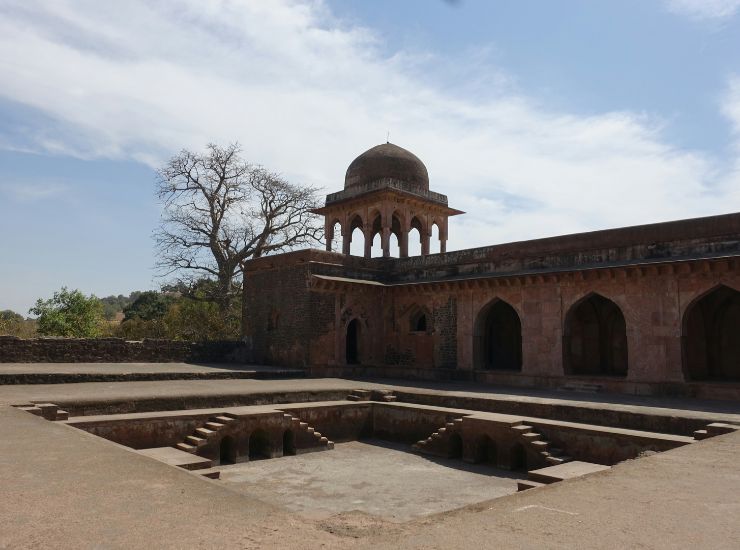
Day 15: Dhar - Mandu (35 km s- One Hour) – Dhar
Morning checkout and drive to Mandu, on arrival transfer to hotel. Later in the day visit Mandu which has over 40 monuments to choose from. For convenience, these are divided into three broad groups: the Central Village Group, the Royal Enclave Group, and the Rewa Kund Group. You can easily spend all day in Mandu, wandering in and out of palaces, pausing to admire the beauty of the Champa Baoli, the former baths, and the huge 15th-century Jama Masjid, the finest example of Afghan architecture in India. Then there are the beautiful Jahaz Mahal (ship palace), where the architectural illusion is completed by the two surrounding lakes; the Hindola Mahal, or swing palace; the romantic Baz Bahadur’s Palace and Roopmati’s Pavilion; and Hoshang Shah’s Tomb, the final resting place of the founder of Ghuri Dynasty. Besides, there are many palaces, pavilions, and reservoirs where you can spend a leisurely day taking in the city’s rather turbulent history, which is not revealed by the monuments that speak of luxurious royal lifestyles. Overnight in Dhar.
Day 16: Dhar - Chota Udaipur - Vadodra (180 km - 3 to 4 hours)
In the morning proceed toward Gujarat, another India state. Stop at Chota Udaipur, passing through a very picturesque landscape. Thereafter proceed to Baroda now called Vadodra, the erstwhile capital of the princely Gaekwads, Vadodra is a graceful city of magnificient palaces, parks, temples and museums. Besides being an important industrial centre, Baroda is also known as the cultural capital of Gujarat. Day free to relax, overnight in Vadodra.
Day 17: Baroda - Ahmedabad (115 km - 2 hours)
In the morning sightseeing of Vadodra visiting the Museum with impressive collections of Art and Archaeology, Pratap Vilas Palace the erstwhile residence of the Royal family to see collection of old armory and sculptures in bronze, marble and terra cotta. Thereafter proceed towards Ahmedabad, graced with splendid monuments built by its founder in 15th Century. Ahmedabad , today is the capital of Gujarat, a very important commercial and cultural centre in western India. Ahmedabad played a prominent role during the freedom movement of India, being the centre of activities of Mahatma Gandhi for some years. Overnight in Ahmedabad.
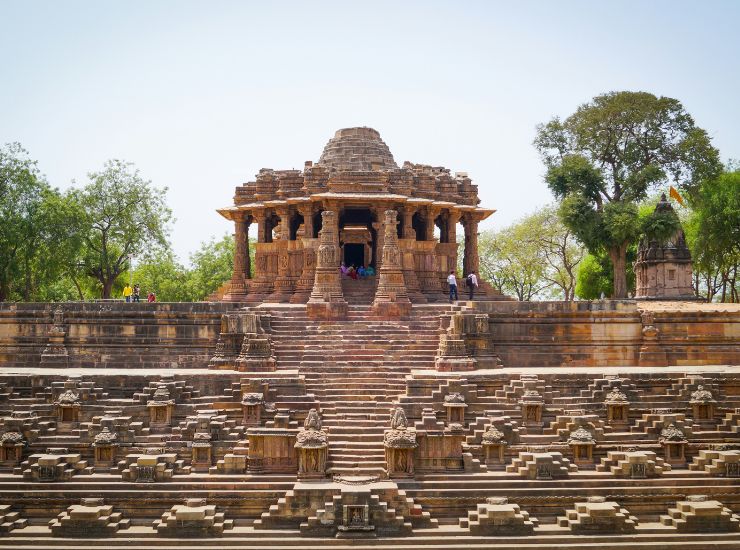
Day 17 : Ahmedabad - Utelia (78 kms - 1 to 2 hours)
Morning visit the famous Sidi Sayyad's mosque known for is exquisite stone window tracery that transforms a stone into a filigree. The Jama Masjid which stands on 26 pillars supporting 15 domes at varying elevations, the extraordinary Calico museum renowned for the large variety of high quality fabrics and the Sabarmati Ashram founded by Gandhi . In the afternoon we continue toward Utelia via Lothal, a place of tremendous archaeological significance, one of the sites associated with the famous Harappan era dating as far back as the 2nd millennium B C. Arrive Utelia and proceed to the Utelia Palace in indo-Saracenic architectural situated in the heart of a colorful village and offers a glimpse of rural life. Utellia was founded in 18th Century. Overnight in Utelia.
Day 18: Utelia - Palitana - Bhavnagar (123 kms - 3 hours)
In the morning depart for the religious city of Palitana famous for the ancient Jain temples. Perched atop the Shatrunjaya hills, there are 863 exquisite marble temples of great religious and artistic importance, containing arches, carved pillars and bejeweled idols. Some of these temples are more than 900 years old. Thereafter continue towards Bhavnagar, once the capital of the princely state now a coastal city. Overnight in Bhavnagar.
Day 19: Bhavnagar - Mumbai (Bombay) (By air)
In the morning after a brief visit of Bhavnagar city transfer to airport to take a flight for Bombay, now called Mumbai. Mumbai is Gateway of India and the capital of Maharashtra . It is country’s foremost sea port, commercial centre and a centre of world’s largest film industry commonly called the Bollywood. Day at Leisure and rest. Depart for the visit of the city: visiting Gateway of India – The imposing stone archway in Indo-Saracenic architecture built in 1911 , Hanging Gardens, the Aquarium and Marine Drive (also known) as "Queens Necklace", the street lights shinning like jewels at night Then visit the museum of Wales, then walk towards the Victoria station and the market of Colaba. Overnight.
Day 20 : Mumbai (Bombay)
Morning take a sightseeing tour of Bombay, drive to Gateway of India and from here cruise by motor boats to Elephanta Caves. A flight of 100 steps takes you to the top of the hill where it is set. The caves houses large pillars that seem to hold the ceiling which is made of cross beams. The picturesque presentation of the 9 marvelous sculptured panels, set on the walls are awe-inspiring. The most famous of the panels is the Trimurthi, or triple-headed Shiva, where the God is depicted as the destroyer, the preserver and the creator. Later in the afternoon cruise back to Gateway of India, one can have lunch at the Taj Hotel or other several good Restaurants like Leopold & Mondegar serving continental cuisines. Later visit Prince of Wales Museum, Parliament House, Marine Drive, Jain Temple, Hanging Gardens, Return back to the hotel for overnight.

Day 21 : Mumbai (Bombay) - Home
In time transfer to international airport to board the flight back home.
* The above tours / itineraries / travel plans can be rearranged / tailormade / customised as desired by our Guests. Feel free to ask for references from our satisfied customers across the globe who have utilised our services in the Indian subcontinent.
Customize Your Madhya Pradesh and Gujarat Tour
This is a private individual tour and can be fully customized to suit your available days, travel preferences, and budget. Our experts are ready to help you create a bespoke tour just for you.
To get started, please contact us with the following details:
- Number of days for touring in India.
- Period of travel (Month of the year)
- Number of people travelling.
- Choice of destination in India (North, South, East, West)
- Choice of Hotels accommodation (Economy, Standard, First Class, Premium)
Send us an email on info@tour-india.net or submit the form with your queries, we will reply you with your tour within 24 hrs. *
East India
West India
North India
South India
Plan Your Journey Today
Ready to explore the wonders of India? Contact us to customize your tour package and embark on a journey of a lifetime.
